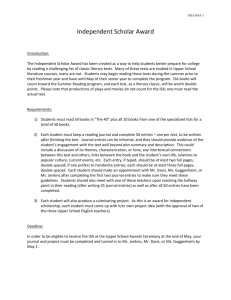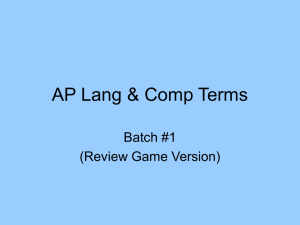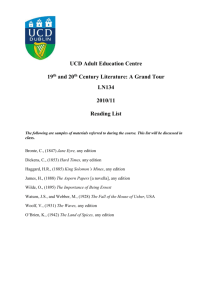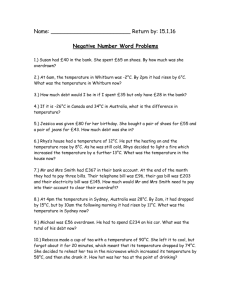CI513 WSS Webquest
advertisement
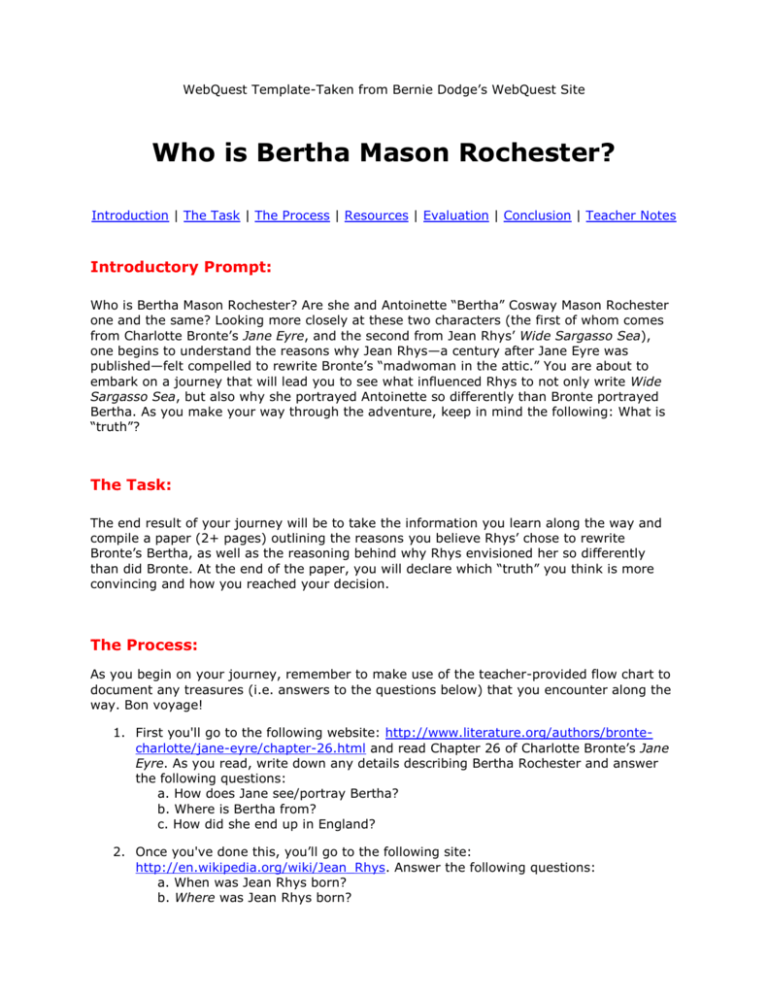
WebQuest Template-Taken from Bernie Dodge’s WebQuest Site Who is Bertha Mason Rochester? Introduction | The Task | The Process | Resources | Evaluation | Conclusion | Teacher Notes Introductory Prompt: Who is Bertha Mason Rochester? Are she and Antoinette “Bertha” Cosway Mason Rochester one and the same? Looking more closely at these two characters (the first of whom comes from Charlotte Bronte’s Jane Eyre, and the second from Jean Rhys’ Wide Sargasso Sea), one begins to understand the reasons why Jean Rhys—a century after Jane Eyre was published—felt compelled to rewrite Bronte’s “madwoman in the attic.” You are about to embark on a journey that will lead you to see what influenced Rhys to not only write Wide Sargasso Sea, but also why she portrayed Antoinette so differently than Bronte portrayed Bertha. As you make your way through the adventure, keep in mind the following: What is “truth”? The Task: The end result of your journey will be to take the information you learn along the way and compile a paper (2+ pages) outlining the reasons you believe Rhys’ chose to rewrite Bronte’s Bertha, as well as the reasoning behind why Rhys envisioned her so differently than did Bronte. At the end of the paper, you will declare which “truth” you think is more convincing and how you reached your decision. The Process: As you begin on your journey, remember to make use of the teacher-provided flow chart to document any treasures (i.e. answers to the questions below) that you encounter along the way. Bon voyage! 1. First you'll go to the following website: http://www.literature.org/authors/brontecharlotte/jane-eyre/chapter-26.html and read Chapter 26 of Charlotte Bronte’s Jane Eyre. As you read, write down any details describing Bertha Rochester and answer the following questions: a. How does Jane see/portray Bertha? b. Where is Bertha from? c. How did she end up in England? 2. Once you've done this, you’ll go to the following site: http://en.wikipedia.org/wiki/Jean_Rhys. Answer the following questions: a. When was Jean Rhys born? b. Where was Jean Rhys born? c. Where was Jean Rhys’ father from? d. Where was Rhys’ mother born? What was her ancestry? e. What is a creole? f. How old was Rhys when she moved to England? g. Do you see any parallels between the lives of Bertha and Rhys? 3. Now you are going to find out a little about what was going on in the West Indies during the time Wide Sargasso Sea takes place. a. Go to the following website: http://plato.stanford.edu/entries/colonialism and answer the questions, 1. What is colonialism? 2. How do you think you would feel if you were a native of a country that had been colonized? b. Go to http://en.wikipedia.org/wiki/Postcolonial_literature and answer the question, What is Postcolonial literature? Note that Wide Sargasso Sea was first published in 1966 when Postcolonial literature was in its early stages. c. Go to http://www.lennoxhonychurch.com/article.cfm?Id=394 and write a Dominican timeline for the period of 1834 to 1844. What is the political climate in the West Indes during this time period? Keep in mind that Wide Sargasso Sea opens in 1833. Why is this significant? 4. Next you are going to look at Rhys societyal/cultural background. a. Go to http://www.lennoxhonychurch.com/jeanrhysbio.cfm and read about why Rhys identified with the black community of her childhood. While you are on this site, take a look at the photo of Rhys as a young woman, as well as the photos of places that were a part of Rhys’ childhood and note any connections there are between these places and Wide Sargasso Sea. b. Go to http://lennoxhonychurch.com/africa-dominica.cfm and write down three influences African culture has had on Dominica. 5. Next, read the information found at at least one of the following. Questions/ideas are provided to guide your reading. a. http://qub.ac.uk/schools/SchoolofEnglish/imperial/carib/janeeyre.htm How does slavery compare to the position of women in the 19 th century? What does this say about Bronte’s differing portrayals of Jane and Bertha? How do you think this disparity made Rhys feel when she read Jane Eyre? b. http://qub.ac.uk/schools/SchoolofEnglish/imperial/carib/colonising-marriage.htm What is the difference between the colonized and the colonizer? How does Antoinette and Rochester’s marriage symbolize colonization (colonizer and colonized)? c. http://www.bibliomania.com/1/7/263/2467/29149/1/frameset.html What is the Wide Sargasso Sea? Where is it? What does the Wide Sargasso Sea symbolize in the novella of the same name? d. http://www.enotes.com/nineteenth-century-criticism/colonialism-victorian-english-literature As a post-colonialist, what does Edward Said say about colonialism in his book, Orientalism (1978)? 6. Finally, you are heading toward the end of your journey. Now it is time to compile the information you have found along the way and think about why Rhys felt compelled to rewrite Bronte’s Bertha. Write a paper (2+ double-spaced pages) outlining the reasons you believe Rhys’ chose to rewrite Bronte’s Bertha, as well as the reasons you think Rhys envisioned her so differently than did Bronte. At the end of the paper, you will declare which “truth” (Bronte’s or Rhys’ version of Bertha/Antoinette) you think is more convincing and how you reached your decision. Resources: Bronte’s Jane Eyre, Chapter 26 http://www.literature.org/authors/bronte-charlotte/jane-eyre/chapter-26.html Biography of Jean Rhys Colonialism Postcolonial literature History of Dominica Rhys’ ties to black community and photographs African influences on Dominica Slavery and the position of women in the 19th century Colonization within marriage in Wide Sargasso Sea http://qub.ac.uk/schools/SchoolofEnglish/imperial/carib/colonising-marriage.htm What is the Wide Sargasso Sea Edward Said on “colonialism” http://en.wikipedia.org/wiki/Jean_Rhys http://plato.stanford.edu/entries/colonialism http://en.wikipedia.org/wiki/Postcolonial_literature http://www.lennoxhonychurch.com/article.cfm?Id=394 http://www.lennoxhonychurch.com/jeanrhysbio.cfm http://lennoxhonychurch.com/africa-dominica.cfm http://qub.ac.uk/schools/SchoolofEnglish/imperial/carib/janeeyre.htm http://www.bibliomania.com/1/7/263/2467/29149/1/frameset.html http://www.enotes.com/nineteenth-century-criticism/colonialism-victorian-english-literature Evaluation: Your performance on the paper will be evaluated using the following rubric: Beginning Developing Accomplished Exemplary Score 1 Student read assigned material Clear thesis statement Clear understanding of cultural differences and background 2 It is evident It is evident through through comments comments made in the made in the paper that the paper that the student read student read at less than half least half of the of the assigned assigned material. material. 3 4 It is clearly evident through comments made in the paper that the student read most of the assiged material. It is clearly evident through comments made in the paper that the student read all of the assigned material. Student unclearly Student clearly Student states states why states why why he/she he/she Student clearly he/she believes Rhys believes Rhys states why he/she believes Rhys decided to decided to believes Rhys decided to rewrite Bronte’s rewrite decided to rewrite rewrite Bertha, Bronte’s Bronte’s Bertha, Bronte’s providing Bertha, providing some Bertha, somewhat providing little textual evidence as providing limited textual or no textual to why the ample textual evidence as to evidence as to protrayal of evidence as to why the why the Bronte’s Bertha why the protrayal of protrayal of affected Rhys so protrayal of Bronte’s Bertha Bronte’s strongly. Bronte’s Bertha affected Rhys so Bertha affected Rhys strongly. affected Rhys so strongly. so strongly. Student Student clearly unclearly Student states states reasons states reasons reasons Rhys Student states Rhys Rhys envisioned reasons Rhys envisioned envisioned “Bertha” so envisioned “Bertha” “Bertha” so “Bertha” so differently than so differently than differently than differently did Bronte, did Bronte, did Bronte, than did providing providing good providing Bronte, somewhat evidence from strong providing little limited evidence assigned readings. evidence from or no evidence from assigned assigned from assigned readings. readings. readings. Student unclearly Declaration of “truth” states which version of Bertha he/she finds more convincing and does not clarify how he/she reached this decision. Student states which version of Bertha he/she finds more convincing but does not clarify how he/she reached this decision. Student states which version of Bertha he/she finds more convincing as well as how he/she reached this decision. Student clearly states which version of Bertha he/she finds more convincing as well as how he/she reached this decision. Conclusion: What is truth? By thinking about the different portrayals of Bertha/Antoinette, you have taking a glimpse into two differing “truths” exemplified through characterization in the works Charlotte Bronte and Jean Rhys. Though Rochester’s first wife is only one “person,” she is perceived quite differently through the eyes of two different women who come from two different cultures and two different centuries. Can you think of other people (or events) with different “truths”? What role does perspective play in these differing views? Teacher’s Notes: Purpose/rationale for the lesson: Why are you teaching this lesson? What State of Oregon content standard/benchmark are you targeting in this lesson? Learning Objectives for the lesson: What do you expect the learners to know and/or accomplish as a result of participating in this lesson? Prior Knowledge/Background Information: What concepts and/or skills do students need to have in order to be successful in this lesson? Key Concept(s): What are 2-3 concepts (related to content and/or process) that students will encounter as a result of this lesson? Include tips/instructions/additional teacher resources for teaching the WebQuest. (This is something you would do after students and you complete this project or assignment.
